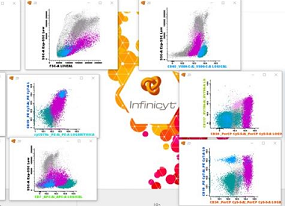In parallel, we use the Infinicyt analysis software, a tool patented by the Euroflow Consistory, which allows us to perform a multi-parametric analysis of millions of complex data contained in the files generated by the cytometers, using common markers in the different staining panels of the cells of cellular interest studied. This cell analysis mechanism allows for improved diagnosis, treatment and monitoring of leukaemias, lymphomas and myelomas, as well as other pathologies.
The Cytometry Area provides services to different medical specialties, mainly Haematology, Pathological Anatomy, Digestology, Neurology, Internal Medicine, Rheumatology, Ophthalmology and Paediatrics. We work with different types of samples: peripheral blood, bone marrow, tissues, adenopathies and fluids.
The studies performed in daily clinical practice can be classified into oncohaematological diagnostic studies and immunological diagnostic studies:


